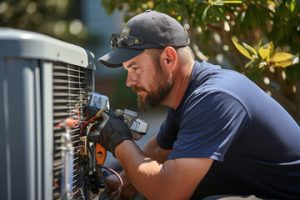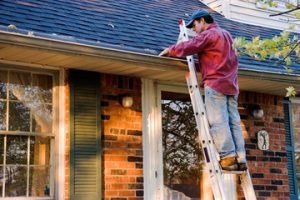A properly working air conditioning system is essential to your home’s comfort. Identifying AC repair issues early can help you prevent them from worsening.
For example, a breaker that continuously trips can indicate problems like oversized equipment or improper thermostat settings. Fixing these issues will save energy. Other issues include low refrigerant, which typically requires a recharge. Contact Ausco Air Heating & Air Conditioning for professional help.
1. Refrigerant Leak

A refrigerant leak is one of the most serious problems an AC can experience. Not only can a leak significantly reduce the system’s ability to cool your home, but it can also result in higher energy bills, system damage, and health risks if not addressed promptly. Refrigerant leaks are usually easy to catch and can be detected through a variety of signs, including reduced cooling capacity, hissing sounds, or ice appearing on the evaporator coils.
Air conditioning repair specialists know the warning signs of a refrigerant leak, and they are trained to quickly locate the leak, seal it, and recharge the system with the proper amount of refrigerant. Leaks can be caused by corrosion on the copper tubes or other components, physical damage, or even by a factory defect during the manufacturing process. However, the most common cause of refrigerant leaks is normal wear and tear, particularly over time.
A hissing sound is a sure sign that the AC is leaking refrigerant. This happens because the refrigerant alternates between being a liquid and a gas in the lines that run between the indoor and outdoor units. As it leaks, the liquid produces a hissing sound and may produce a bubbling sound as well. Some leaks can produce a sweet or sickly odor, while others can emit a noticeable smell, such as antifreeze.
Other common signs of a refrigerant leak include ice on the evaporator coils and longer than usual cooling cycles. The best way to avoid refrigerant leaks is through regular maintenance service, which includes checking and testing the air conditioner for proper function and recharging it with the correct amount of refrigerant. In addition to catching and fixing refrigerant leaks, regular maintenance will help prevent many other issues that can occur in an AC.
2. Thermostat Issues
Thermostats play a critical role in the functionality of your AC system. They are responsible for sending the system control signals that turn the unit on and off, ensuring it follows your desired temperature settings. When your thermostat isn’t functioning properly, it may cause various issues, from inefficient cooling to higher utility bills. Fortunately, there are several troubleshooting steps and repair options to restore your thermostat’s functionality and prevent the occurrence of further problems.
Whether your thermostat is an older programmable model or a state-of-the-art smart thermostat, power and connectivity problems are common culprits in their failure to function effectively. Loose or corroded wiring connections disrupt the thermostat’s ability to communicate with the AC system, leading to inaccurate readings and misalignment of the indoor and outdoor temperatures. In some cases, a loose wire may simply need to be reconnected, while other times, the thermostat may need to be replaced entirely.
A blank thermostat screen is a clear sign that the device isn’t receiving power. If this is the case, it can often be resolved by checking to ensure that the battery is in place and working correctly. In more serious cases, the problem could be a tripped circuit breaker. In these situations, you’ll need to visit your breaker box to find the breaker that controls the thermostat and switch it to the on position.
Other signs of a failing thermostat include inconsistent cooling between rooms and a higher-than-normal energy bill. These problems indicate that the thermostat is wasting energy by sending incorrect signals to the AC system or overworking the system due to an inefficient design.
Additionally, if the AC system is cycling on and off frequently, it might be a sign of a malfunctioning thermostat sensor. This issue will cause the compressor to shut off before it’s finished with its cycle, leading to an inefficient system and increased energy bills. A qualified professional can inspect the thermostat and make any necessary repairs to restore its function and prevent unnecessary strain on the compressor. A professional can also help you select and install a new thermostat to improve energy efficiency.
3. Blower Motor Issues
The blower motor is an essential component in delivering consistent airflow throughout your home. It can be impacted by physical damage, as well as problems with electrical connections or wiring. If you suspect your blower motor is experiencing issues, it’s important to contact an HVAC professional right away to avoid further system damage and costly repairs.
One of the most common signs that your blower motor is beginning to fail is a lack of airflow from the vents. This may be caused by a malfunctioning fan wheel or a clogged blower resistor. Other signs include unusual noises, which often come in the form of squealing or screeching sounds. If you notice these strange noises, it’s important to shut down the AC and check for a power supply problem or thermostat settings that need to be adjusted.
Another sign that your blower motor is failing is an increase in electricity usage. This is typically because the blower motor is consuming more energy due to increased systematic resistance. If you notice an increase in your energy bills, it’s a good idea to call a professional for a blower motor inspection and replacement.
If your blower motor isn’t working at all, it can be a sign that the control board or fuses are bad. It can also mean that the motor is burnt out or clogged with debris. Usually, disconnecting the electrical connector and jumping out 120 volts to the motor will let you know whether or not it’s still functioning.
Finally, a faulty ground connection can disrupt the flow of electricity and cause your blower motor to fail. This could be due to rust, corrosion, or disconnected wires. It’s important to ensure that all ground connections are tight and rust-free, and a professional will be able to check for these issues.
Other signs that your blower motor is faulty include an odd smell or burning, which can occur when the bearings are wearing out. These symptoms are a sign of overheating and can be dangerous if ignored. If you notice these signs, shut down your system and immediately call a professional to inspect the blower motor.
4. Contactor Issues
Your AC’s contactor relay switch is designed to start the outdoor condenser unit and receive a signal from your air conditioner thermostat. When a problem with this part occurs, it can cause the system to malfunction and fail to perform its job correctly. You’ll typically notice the issue by a humming, buzzing or chattering noise, which indicates mechanical problems within the contactor. This component can wear out due to electrical arcing, or from physical deterioration caused by environmental factors and overheating. Moisture exposure, for example, can corrode the electrical contacts, resulting in pitting and excessive charring that prevents proper conductivity. In addition, pests or dirt can cause the metal coils and plunger to rust or become loose, leading to mechanical failure.
A contactor failure often leads to a number of issues, including short-cycling and inefficient cooling. A faulty contactor can also interrupt power flow to the compressor and fan motor, increasing energy usage and raising utility bills. In addition, a bad contactor may cause voltage fluctuations that put additional strain on other components and lead to overheating.
You can test the status of your contactor using a multimeter. Before performing this task, ensure that all power is shut off at both the thermostat and breaker level to avoid electrocution. You can then open the side of your outdoor unit, exposing the wires connected to the contactor. You’ll see a black rectangle that’s positioned vertically and has several colored wires attached to it. Taking a picture of the wiring and contactor will help you remember how to reconnect them once it’s replaced.
A healthy contactor makes a distinct clicking sound when it engages. Listening for this sound can help you detect a contactor issue before it worsens. If you hear a chattering or humming noise instead, it’s time to replace the contactor. You can also visually inspect the component for telltale signs of wear and tear, such as pitting, corroding, or excessive charring on the contactor points. Replacing the part early can save you money, stress, and other problems down the road. Regular maintenance by an experienced technician can catch contactor problems before they become more serious.








